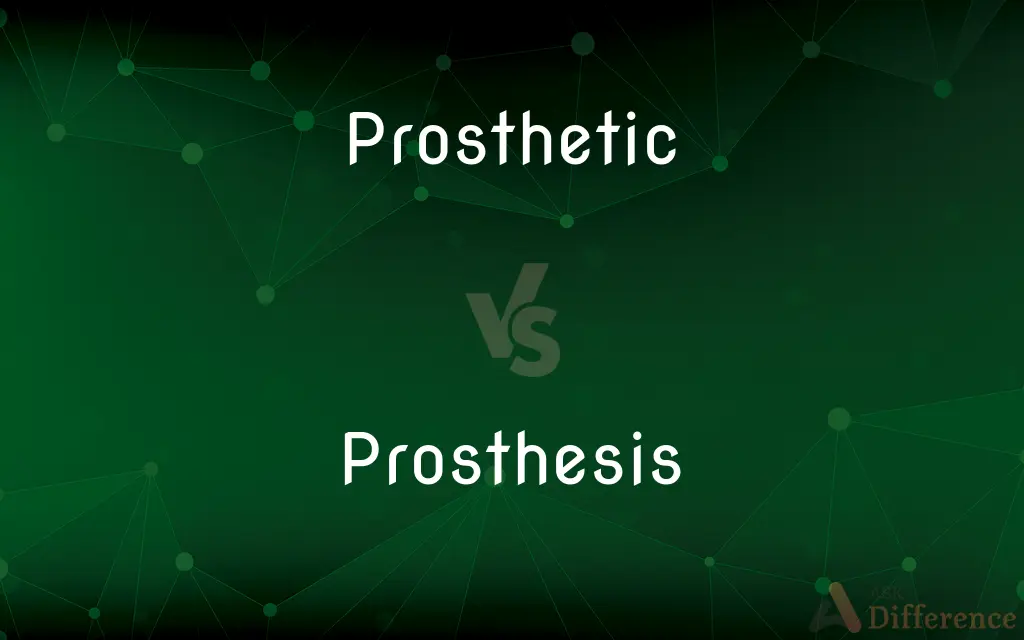Prosthetic vs. Prosthesis — What's the Difference?
By Maham Liaqat & Fiza Rafique — Updated on April 2, 2024
Prosthetic refers to the adjective describing devices replacing missing body parts, while prosthesis denotes the actual artificial device.

Difference Between Prosthetic and Prosthesis
Table of Contents
ADVERTISEMENT
Key Differences
Prosthetic is an adjective used to describe devices designed to replace or support missing body parts or functions, indicating the field of study or the nature of these devices. On the other hand, prosthesis is a noun that specifically refers to the artificial device itself, such as a limb or dental part, used to replace a missing or defective body part.
The term "prosthetic" can be applied in broader contexts, not just to the devices but also to materials, technology, and the science involved in creating these aids. Whereas, "prosthesis" is used to refer to the actual item that an individual might use, focusing on the tangible aspect.
Prosthetic technology encompasses the development, design, and materials used to create artificial devices, indicating a wide range of expertise from biomechanics to material science. Prosthesis, however, focuses on the application and the functional replacement of the body part, directly impacting the user's quality of life.
Prosthetic devices are a product of prosthetic technology, illustrating the relationship between the field (prosthetic) and the outcomes (prosthesis). In conversation, prosthesis is often discussed in terms of its fit, function, and impact on the individual's daily activities, highlighting its personal and practical aspects.
The advancements in prosthetic science have significantly improved the quality, functionality, and appearance of prostheses, making them more efficient and comfortable for users. This distinction emphasizes the difference between the area of study and development (prosthetic) and the actual devices (prosthesis) that benefit individuals.
ADVERTISEMENT
Comparison Chart
Definition
Adjective describing devices that replace or support missing body parts.
Noun referring to an artificial device that replaces a missing body part.
Usage
Describes the field of study, materials, and technology used to create artificial devices.
Refers to the actual artificial device used by an individual.
Focus
Broad, covering the science, technology, and art of creating artificial body parts.
Specific, on the tangible device and its application for the user.
Example Context
Prosthetic technology has advanced significantly in recent years.
The prosthesis improved the patient's mobility significantly.
Relation
Indicates the category or field related to artificial devices.
Represents the outcome or product within the prosthetic field.
Compare with Definitions
Prosthetic
Involves biomechanics, material science, and design to create functional artificial limbs.
Advances in prosthetic technology have led to the development of bionic hands with touch sensitivity.
Prosthesis
Differentiates between various kinds of prosthetic devices.
She chose a cosmetic prosthesis that closely matched her skin tone and appearance.
Prosthetic
Pertaining to the art and science of developing artificial devices to replace missing body parts.
Prosthetic limbs have become more sophisticated, offering greater movement and control.
Prosthesis
An artificial device used to replace a missing body part, such as a limb, tooth, or eye.
His new leg prosthesis allowed him to walk and run more naturally.
Prosthetic
Refers to the materials and engineering behind artificial limbs.
Modern prosthetic devices use lightweight materials like carbon fiber for enhanced comfort.
Prosthesis
Describes the direct effect of the device on the user's life and capabilities.
With his new arm prosthesis, he was able to return to work and daily activities.
Prosthetic
Highlights the progress in technology aiding the development of prosthetics.
3D printing has revolutionized prosthetic production, making it more accessible and customizable.
Prosthesis
Focuses on the use and functionality of the artificial device for the individual.
The dental prosthesis restored her ability to chew and speak clearly.
Prosthetic
The role of prosthetic devices in improving the lives of individuals with limb loss.
Prosthetic advancements have significantly enhanced the mobility of individuals with amputations.
Prosthesis
The process of tailoring the prosthesis to the individual's specific needs.
The prosthesis was custom-fitted to ensure it was comfortable and functional for daily use.
Prosthetic
Serving as or relating to a prosthesis.
Prosthesis
In medicine, a prosthesis (plural: prostheses; from Ancient Greek prosthesis, "addition, application, attachment") or prosthetic implant is an artificial device that replaces a missing body part, which may be lost through trauma, disease, or a condition present at birth (congenital disorder). Prostheses are intended to restore the normal functions of the missing body part.
Prosthetic
Of or relating to prosthetics.
Prosthesis
An artificial device used to replace a missing body part, such as a limb, tooth, eye, or heart valve.
Prosthetic
Artificial, acting as a substitute for part of the body; relating to prosthesis
Prosthetic leg/arm
Prosthesis
Replacement of a missing body part with such a device.
Prosthetic
An artificial replacement for part of the body; a prosthesis, prosthetic device.
Prosthesis
(Linguistics) Prothesis.
Prosthetic
An addition to an actor etc.'s body as part of a costume, intended to transform the person's appearance.
Prosthesis
(medicine) An artificial replacement for a body part, either internal or external.
Prosthetic
Of or pertaining to prosthesis; prefixed, as a letter or letters to a word.
Prosthesis
Prothesis.
Prosthetic
Of or relating to prosthetics
Prosthesis
The addition to the human body of some artificial part, to replace one that is wanting, as a log or an eye; - called also prothesis.
Prosthetic
Relating to or serving as a prosthesis
Prosthesis
The prefixing of one or more letters to the beginning of a word, as in beloved.
Prosthesis
Corrective consisting of a replacement for a part of the body
Common Curiosities
How is a prosthesis customized for an individual?
A prosthesis is customized through precise measurements, consideration of the individual’s activity level, and the specific functionality required.
What impact do prosthetic devices have on individuals?
Prosthetic devices significantly improve the quality of life for individuals with limb loss, enhancing mobility, functionality, and psychological well-being.
What advancements have been made in prosthetic technology?
Recent advancements include the development of bionic limbs, improved material use like carbon fiber, and customization through 3D printing.
Are prosthetic devices only for limbs?
No, prosthetic devices can also include dental prostheses, ocular prostheses, and others designed to replace different missing body parts.
What materials are used in making a prosthesis?
Prostheses are made from various materials, including plastics, metals, carbon fiber, and silicone, depending on the device’s purpose and desired characteristics.
What is the difference between prosthetic and prosthesis?
Prosthetic is an adjective describing devices or the field related to replacing body parts, while prosthesis is the noun for the actual artificial device.
Can the term prosthetic be used as a noun?
While commonly used as an adjective, "prosthetic" can informally refer to a prosthesis, but its correct usage is as an adjective.
Are there cosmetic prostheses?
Yes, cosmetic prostheses are designed to replicate the appearance of a missing body part, focusing on aesthetics rather than function.
How does a prosthesis improve mobility?
A prosthesis replaces the function of a missing limb, allowing for improved mobility and the ability to perform daily activities.
What challenges do individuals face with prostheses?
Challenges can include initial discomfort, the need for regular adjustments, and learning to use the prosthesis effectively.
Can prosthetic devices provide sensory feedback?
Some advanced prosthetic devices can provide sensory feedback through electronic sensors that mimic touch or pressure sensations.
What is the role of a prosthetist?
A prosthetist is a healthcare professional specialized in designing, fitting, and customizing prosthetic devices for individuals.
How do individuals adapt to using a prosthesis?
Adaptation involves physical therapy, practice, and adjustments to the prosthesis for comfort and functionality.
Share Your Discovery

Previous Comparison
Exogamous vs. Endogamous
Next Comparison
Grip vs. GraspAuthor Spotlight
Written by
Maham LiaqatCo-written by
Fiza RafiqueFiza Rafique is a skilled content writer at AskDifference.com, where she meticulously refines and enhances written pieces. Drawing from her vast editorial expertise, Fiza ensures clarity, accuracy, and precision in every article. Passionate about language, she continually seeks to elevate the quality of content for readers worldwide.
















































